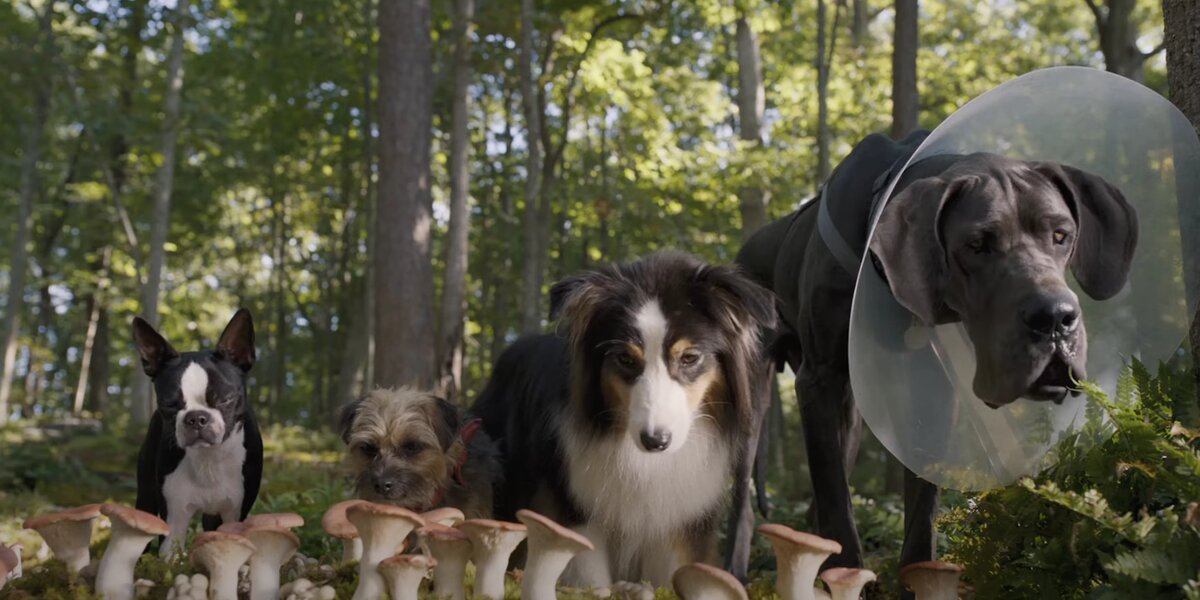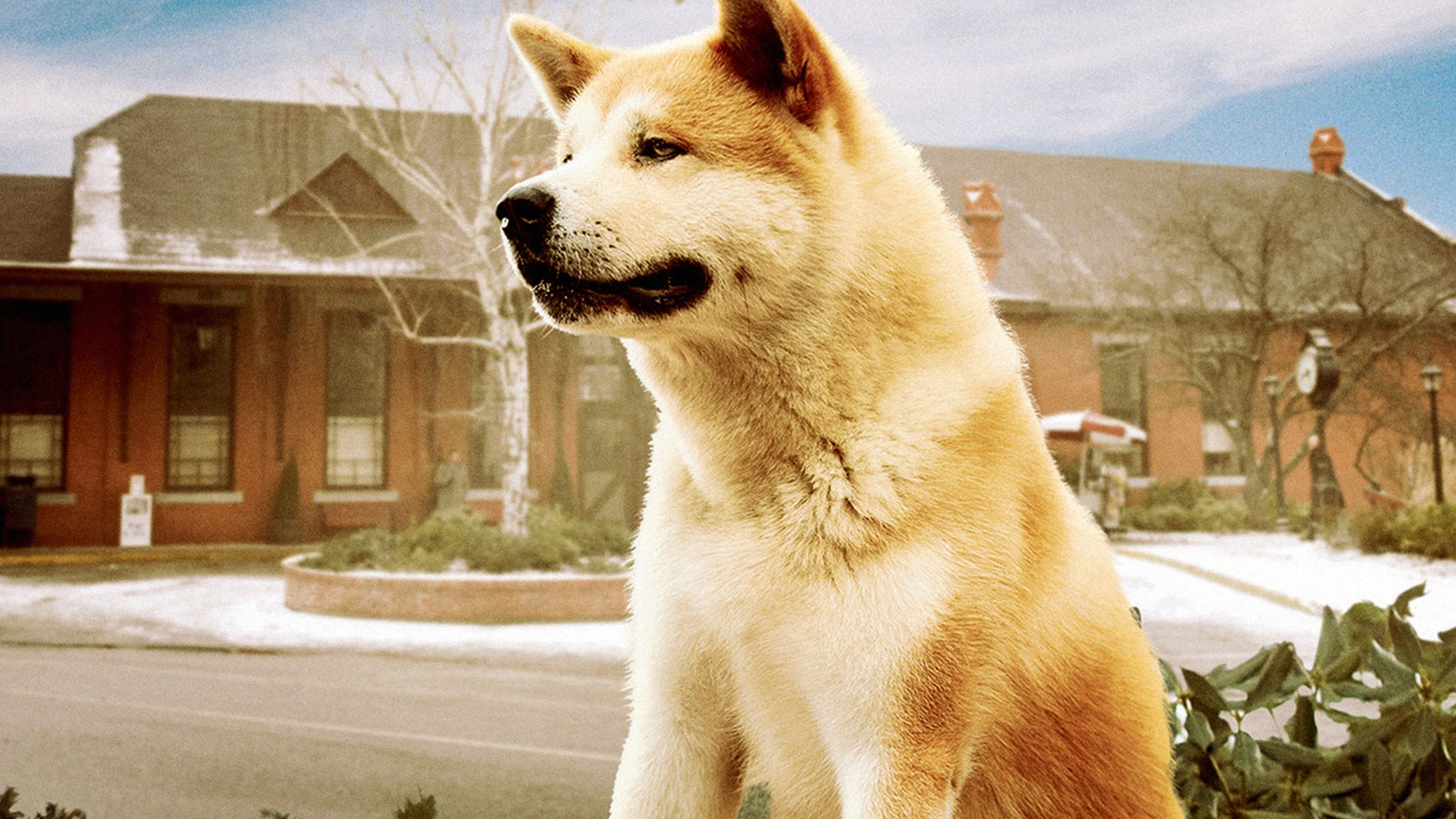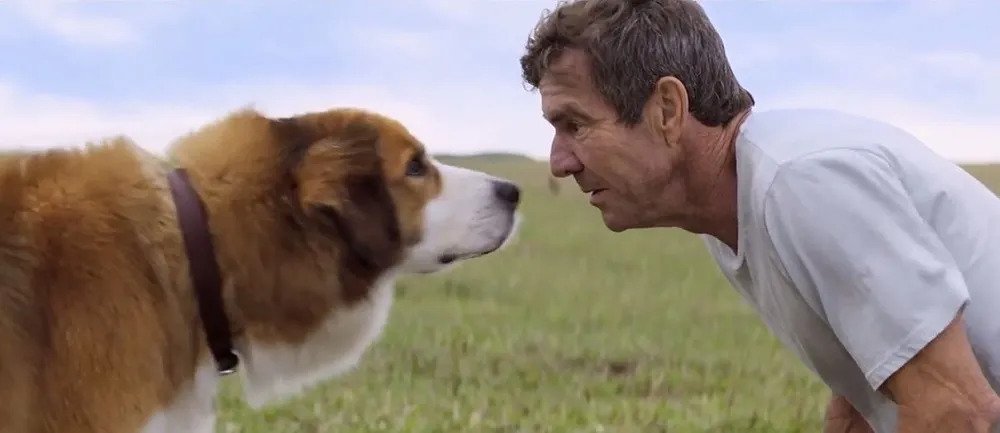Strays is not a good movie. However, it is an interesting cultural object, bringing a recent trend in Hollywood moviemaking into focus. After all, many spoof movies are responses to popular genres, with Airplane! riffing on classic disaster movies and Blazing Saddles satirizing the western. The best of these movies outlive the genres that they spoof. Strays is unlikely to do that, but it does provide an interesting snapshot of a cinematic movement perhaps described as “the new good boy canon.”
For almost as long as there have been movies, there have been dogs in movies. Blair the Dog was a star of early British silent films, such as Rescued by Rover from 1905 and its sequel The Dog Outwits the Kidnapper from 1908. In America, a tricolor Scotch collie named Jean starred in 25 silent movies between 1910 and 1916. Charlie Chaplin enjoyed great success with his short, A Dog’s Life, which would go on to be a major influence on The Kid, which itself featured some great dog-centric bits.
People like dogs. It transcends language, demonstrated by their ubiquity in silent films, even modern examples like The Artist. Since 2001, critics at the Cannes Film Festival have handed out a “Palm Dog” award. Canine characters can reach a level of ubiquity reserved for the biggest bipedal stars. Dr. No director Terence Young once mused, “There are only two great stars in my recollection who have not been changed by great massive success: Sean Connery and Lassie, and both of them Scottish.”
Historically, the trend has suggested that these pooch performers were largely suited to children’s entertainment. Many of the most obvious dog-centric movies of the talkie era were animated family films like 101 Dalmatians, The Lady and the Tramp, All Dogs Go to Heaven, and even Rover Dangerfield. Even live action mutt movies tended to be aimed at the youngest and least discerning of viewers, from The Shaggy D.A. to Homeward Bound to The Shaggy Dog to Beethoven and beyond.
Strays is aware of this. Much of the movie’s humor derives from the juxtaposition of taking a seemingly family-friendly setup like the classic talking dog movie, and then transgressing within that framework. At its core, this is a movie built around the template of Homeward Bound. Reggie (Will Ferrell) is a dog abandoned by his owner Doug (Will Forte), who is desperate to get back home before Doug moves. The dogs featured in the movie swear, poop, take drugs, and have sex.

However, Strays is also engaged with a more modern trend within the canine canon. The turning point came 15 years ago. 2008 was an important year in determining the future arc of American moviegoing. The Dark Knight and Iron Man laid out two competing visions of what superhero blockbusters could look like. However, there was also a battle being waged over the future of the dog movie — one that would have profound and long-lasting consequences.
In one corner, Beverly Hills Chihuahua represented the old guard. It was a talking dog movie, a broad family comedy starring the voices of Drew Barrymore, Andy García, and George Lopez, of a piece with films like Cats & Dogs. Beverly Hills Chihuahua earned largely negative reviews, but was popular enough with audiences that it made $149 million worldwide and received an “A” CinemaScore. It even spawned two sequels, albeit ones that went direct to video.
In the other corner, there was Marley and Me. Adapted from John Grogan’s memoir, Marley and Me was a much more prestigious project. Most obviously, the dog did not talk. More than that, the film was clearly aimed at an older audience, focusing on the dysfunctional relationship between writer John (Owen Wilson) and his new wife Jenny (Jennifer Aniston). Insecure about Jenny’s professional success and wanting her to settle down to have kids, John follows the advice of a friend (Eric Dane) and adopts Marley, a yellow Labrador retriever.
Marley may not talk, but the dog has a lot to teach. He becomes a creative muse for John, inspiring his twice-weekly column. He also serves to bring John and Jenny closer together, allowing the couple to have three kids. Marley and Me is interesting, because it is a dog movie that grapples with ostensibly adult themes: marriage, parenting, postpartum depression, career insecurity. It was also a massive success, earning $255 million at the global box office and comparatively positive reviews.
In Strays, Doug hasn’t watched Marley and Me, but he’s aware of it. To a certain extent, the film can be understood as a light riff on the basic premise of Marley and Me. After all, Reggie was adopted by Doug and his partner Ashley (Jade Marie Fernandez). While it’s possible to read Marley and Me as a story about how John suppresses his feeling of masculine inadequacies in a way that allows Marley to serve as “an external manifestation of John’s id,” Strays inverts this by casting Doug as pure id.
Still, one movie does not make a trend. This push towards more prestige pupper pictures that began with Marley and Me was cemented the following year with the release of Hachi: A Dog’s Tale. While Marley and Me featured stars-of-the-moment Jennifer Aniston and Owen Wilson, Hachi was built around classic 1980s and 1990s movie star Richard Gere. More than that, with a supporting role for Jason Alexander, Hachi was a low-key reunion for Pretty Woman, one of the highest-grossing movies of 1990.

In a match made in hound heaven, Hachi was directed by Lasse Hallström. Hallström had been nominated for the Academy Award for Best Director twice, for the Swedish film My Life as a Dog and for folksy abortion drama The Cider House Rules. Hallström would remain a key figure in this rover renaissance, also directing A Dog’s Purpose. Hachi didn’t make that much money in its theatrical release — only $46 million — but there are other ways of measuring a movie’s cultural cachet.
While Beverly Hills Chihuahua was once listed among the Worst 100 Movies of All Time at IMDb, Hachi has consistently ranked among their Top 250 Movies of All Time. In January 2014, Hachi was apparently the most popular movie in Rhode Island, beating out Dumb and Dumber. However, despite starring Richard Gere, the movie could not secure a theatrical window in the United States and had to be broadcast on the Hallmark Channel.
It is notable where the movie was successful. According to star Cary-Hiroyuki Tagawa, it rolled out very well internationally. On IMDb, only about 37,000 of the 299,000 user votes come from the United States, lower than many other titles. On Douban, the Chinese answer to the IMDb, Hachi ranks comfortably among the twenty best films ever made, beating out competitors like The Godfather or The Dark Knight. The film even has a Chinese remake.
China is a growing market for American films, as evidenced by the success of movies like World of Warcraft or The Meg. Dog movies tend to play particularly well in China, with A Dog’s Purpose earning $88 million in China compared to $64 million in the United States. China is so fond of these American canine stars that they produced an anthology film, Adoring, featuring a number of veteran Hollywood stars like Luther from Pup Star, Que from Show Dogs, and Benny from Dog Days.
The twin successes of Marley and Me and Hachi: A Dog’s Tale seemed to set the course for the new canine canon, leading to a whole set of very treacly and earnest films in which dogs impart life lessons to either their owners or the viewing audience. Another obvious touchpoint for the genre was A Dog’s Purpose from 2017. This film was something of a crossbreed, trying to wed this new up-market sincere dog movie with the classic trope of the talking dog.
A Dog’s Purpose features Josh Gad as the voice of a dog – known as “Boss Dog” – that finds itself tasked with guiding and shaping the lives of the Montgomery family. To do this, “Boss Dog” reincarnates several times, hoping each death will get them closer. None of the human characters can hear Boss Dog’s profound ruminations on the human condition, but they are eventually reunited with their aged owner, Ethan (Dennis Quaid).

A Dog’s Purpose and its sequel, A Dog’s Journey, are a very obvious touchstone for Strays, to the point that its two biggest cameos are built around it. Josh Gad makes a small appearance as Gus, “one of them narrator dogs” who considers himself too posh to speak directly to the movie’s other talking canines. Later on, there is a brief cutaway gag to Dennis Quaid, an appearance that only really makes sense in the context of his appearances in those two movies.
Its arc once again intertwined with the superhero blockbuster, when the prestige pooch picture hit market saturation in 2019. This was the year that A Dog’s Purpose author W. Bruce Cameron seemed to exert maximal impact on the culture. Not only did Universal adapt his sequel, A Dog’s Journey, but Sony released an adaptation of his other big dog book, A Dog’s Way Home. However, “the new good boy canon” reached its apotheosis with that year’s release of The Art of Racing in the Rain, adapted from Garth Stein’s novel.
The Art of Racing in the Rain is perhaps best understood as the Book of Job narrated by a race-car-loving golden retriever. It’s the story of Denny (Milo Ventimiglia), a racing driver who finds himself beset by tragedy upon tragedy. After his wife, Eve (Amanda Seyfried), dies of brain cancer, his father-in-law, Maxwell (Martin Donovan) tries to take custody of his daughter, Zoë (Ryan Kiera Armstrong). In a heated argument, Maxwell falls, breaking his rib. He uses this injury to derail Denny’s career.
If Hachi banked on the old-fashioned 1980s and 1990s movie star charisma of Richard Gere to bolster his canine co-star, The Art of Racing in the Rain goes one step further, casting Kevin Costner as Denny’s loyal dog Enzo. It’s a surreal film, part harrowing family drama and part cute dog movie. It’s a movie where Maxwell threatens to destroy Denny’s family and career, only for Enzo to use “the tools of [his] dogness to exact justice” by deliberately fouling himself on Maxwell’s beloved rug.
2019 represented a peak for this movement, but its legacy lingers on. Chris Sanders’ adaptation of The Call of the Wild, starring Harrison Ford, owes more to these recent doggy dramas than it does to earlier movies like Snow Dogs, with critic Kim Newman comparing it to “an animal version of 12 Years a Slave.” Perhaps the release of Strays suggests that the genre has had its heyday, that it’s less of an ongoing concern than a building block to whatever the next movement in animal cinema will be.
It’s interesting to wonder why these films became so popular and so profound. Perhaps it’s because millennials and Gen Zers can empathize. Those generations are marrying later, putting off having kids, and can’t afford houses. However, they d0 own pets — and love them, often more than family. Perhaps it’s more basic than that. As the world seems more divided than ever, there’s something appealing in the belief that even an animal as simple as a dog might hold the key to life’s mysteries.






Published: Aug 23, 2023 10:00 am